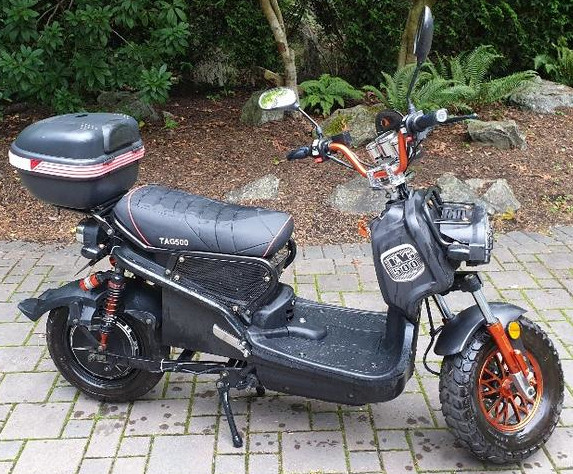 Terrence Wojtkiw was issued a violation ticket for three Motor Vehicle Act offences while riding a TAG 500 electric scooter equipped with pedals. He had modified this motor assisted cycle (MAC) so that it no longer qualified for exemptions under the Motor Vehicle Act. He disputed the ticket.
Terrence Wojtkiw was issued a violation ticket for three Motor Vehicle Act offences while riding a TAG 500 electric scooter equipped with pedals. He had modified this motor assisted cycle (MAC) so that it no longer qualified for exemptions under the Motor Vehicle Act. He disputed the ticket.
A Motor Assisted Cycle Must Have Working Pedals
At the time, the pedals had been installed so that they were side by side instead of opposed to each other, in addition to being positioned behind the usual part of the seat used by the driver. They were essentially useless for propelling the machine.

Definition of MAC
"motor assisted cycle" means a device prescribed as a motor assisted cycle for the purposes of section 182.1
Further regulations referred to are found here.
Maximum Speed of 32 KM/H
When Mr. Wojtkiw came to the attention of police, he was traveling at 48 km/h on level ground. The motor governor had either been disconnected or had ceased to function as required.
A MAC must not be able to move faster than 32 km/h on level ground.
The Judicial Justice Erred
The Judicial Justice in traffic court found that the machine qualified as a Motor Assisted Cycle and dismissed some or all of the charges.
Crown appealed the decision and Madam Justice Murray found the Judicial Justice's decision unreasonable.
[31] I am sympathetic to Mr. Wojtkiw’s concerns about obtaining a driver’s licence and insurance to operate his scooter—if insurance is available. I also understand that Mr. Wojtkiw relies heavily on his scooter to travel throughout Victoria, particularly to travel to and from work. However, I cannot overlook the fact that, as this court has held in Rei and Ghadban, the essential components of a MAC under the MVA and the MAC Regulation are functional pedals with a motor to assist pedaling, as well as a motor that does not propel the cycle over 32 km/hr on level ground. Mr. Wojtkiw’s scooter does not meet either of these requirements.
She ordered a new trial to be held.
Share This Article
- Log in to post comments
